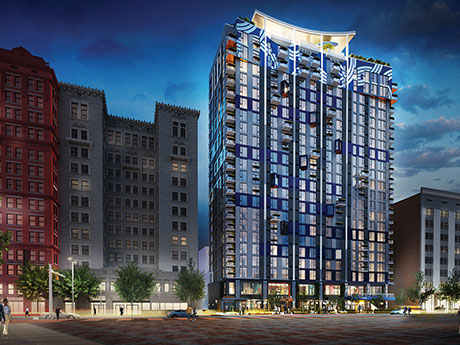By Jamie Dunford, CBRE
Outside of office product, Cleveland and Northeast Ohio haven’t historically been of interest for most out-of-town multifamily developers and investors. They viewed the region as a tertiary or secondary market with a declining population and a lackluster economy.
Until recently, urban living in the central business district (CBD) and surrounding neighborhoods was rare — Cleveland was a commuter city with a strong office market from the 90s until the Great Financial Crisis (GFC) in 2008. At one point in time, Northeast Ohio boasted one of the highest concentrations of Fortune 500 companies with headquarters or other office space in the region, and the CBD had the largest job hub in the state of Ohio.

Most office buildings in the CBD were owned by institutional capital or national developers. However, the GFC vastly altered this landscape as unemployment rose, companies left or downsized, and many office assets went back to the lender.
This left an oversupply of office product in the market, and the older buildings suffered the most. However, this created a market opportunity that Cleveland developers seized, and the city eventually became a national leader in converting historic office assets to multifamily while taking advantage of historic tax credits.
When one door closes…
In 2010, approximately 9,000 residents called the downtown CBD home. A high concentration of that population resided in the historic warehouse district, where old industrial warehouses were converted to apartment units. The success of these conversions provided the playbook for developers to convert historic office assets into multifamily properties.
This led to a boom in historic office conversions to multifamily over the next decade, which more than doubled the population of the CBD to over 20,000 residents in 2020. In total, historic conversions have delivered over 4,000 apartments, with another 2,250 units currently under construction or planned. From 2016 through 2024, roughly 6 million square feet of historic office space will have been converted to multifamily.
The most impressive thing about this historic conversion renaissance has been the absorption in the market. Most of these buildings were stabilized in under 12 months, with many of them approaching stabilization through pre-leasing before construction was completed.
It highlights the incredibly strong demand from millennials and recent college graduates who desire an urban living environment where they can embrace the live-work-play lifestyle. This success caught the eye of ground-up developers locally, regionally, and even nationally, paving the way to something many Clevelanders thought would never materialize — new construction.
If you build it, they will come
The Flats at East Bank was the first major new construction project in the CBD coming out of the GFC. Developed by The Wolstein Group in 2013, this ambitious master-planned district proved to be wildly successful and catalyzed new construction not only throughout the CBD, but also in the surrounding neighborhoods.
Some other notable high-profile projects that followed include:
• The Lumen: a 318-unit, luxury high-rise built in the heart of the CBD by Hines and Playhouse Square Foundation
• INTRO: the largest residential mass timber structure in the U.S. and one of the preeminent developments in the Midwest built by Chicago-based Harbor Bay Ventures
• Bolivar Apartments: a 184-unit property currently under development by a joint venture between New York-based Somera Road and Chicago-based Leopardo Cos.
• City Club Apartments Cleveland: a 304-unit high-rise currently being built by Detroit-based City Club Apartments
In addition to these projects, thousands of new-construction units have been delivered within Cleveland proper over the last three years with several thousand more under construction and planned.
More demand forecasted
Recently, the Downtown Cleveland Alliance and Greater Cleveland Partnership commissioned a report from Urban Partners, a Philadelphia-based community and economic development consulting firm, on the state of the Cleveland CBD. Urban Partners concluded that the Cleveland CBD can support an additional 4,000 to 6,500 apartment units through 2032. This falls in line with population growth estimates that the CBD will reach 30,000 residents by 2030.
National buyers agree with this conclusion, as recent property sales have attracted new investors to the region, highlighted by Town Management’s $100+ million acquisition of The Archer and Bingham Apartments in the CBD and Solomon Organization’s $175+ million suburban portfolio acquisition in 2020, to name a few.
Furthermore, cap rates are now consistently sub 6 percent and some properties have even traded in the 4 percent cap range when debt was less expensive. The market’s increased attention is due to strong rental market fundamentals, an underappreciated employment base driven by our world-renowned healthcare industry, and a low cost of living.
While sales inventory is somewhat scarce currently due to buyer and seller disconnect — largely attributable to the cost of debt — we believe that once interest rates stabilize or decrease, a wave of transactions will follow. Hold periods are coming up, incentives are burning off and numerous historic conversions will have their tax credits roll over, setting the scene for eventual dispositions throughout Cleveland.
Jamie Dunford is a senior associate with CBRE Capital Markets. This article originally appeared in the August 2023 issue of Heartland Real Estate Business magazine.


